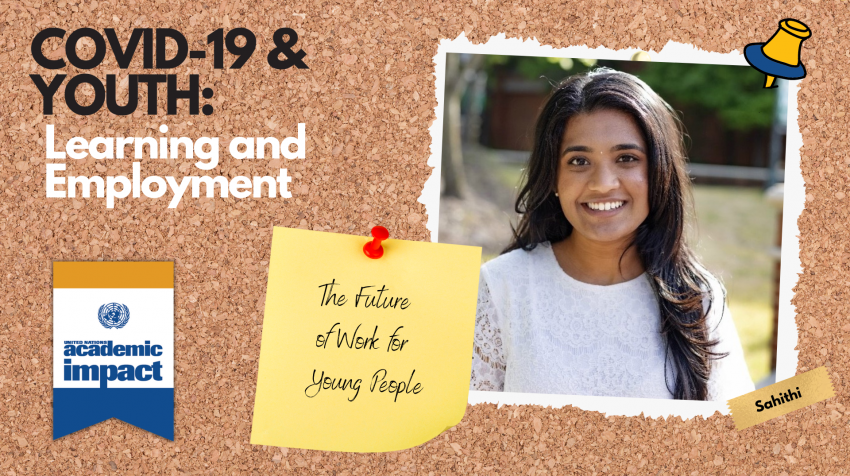The COVID-19 pandemic has had an unequivocal impact on young people. An International Labour Organisation (ILO) study found that ‘the impact of the pandemic on young people [is] systematic, deep and disproportionate.’ Twenty-three per cent of young people aged 18-24 who were working pre-pandemic are now unemployed, and those who are working have reported reductions in hours and income. “Students’ perceptions of their future career prospects are bleak, with 40 per cent facing the future with uncertainty and 14 per cent with fear,” the report adds. Globally, young people are feeling more uncertain about what the future holds.
In this COVID-19 and Youth: Learning and Employment interview series, the United Nations Academic Impact (UNAI) looks to explore trends and patterns within the global youth education and labour environment, and highlight youth voices on their hopes and fears for the post-COVID future.
“I was the lucky one, saved by my master’s degree.”
Sahithi, who graduated from UNC Charlotte, USA, and is an incoming security engineer at Amazon in Boston, was fortunate enough to land a job during the COVID-19 pandemic. “Everyone has a bachelor’s degree these days. What sets you apart (from the rest of young people) is having that additional degree,” she says. That is one of the reasons Sahithi had initially decided to move on to the master’s program, as she “knew it would be beneficial down the line.” Her instinct turned out to be right. Still, she was nervous when she started applying for jobs during the pandemic, a turn of events unforeseeable back then.
Her friends were not as fortunate. Sahithi explains that “there were some former classmates who had trouble getting a job after their education.” She thinks her master’s degree in cyber security, a field which has become more appealing to businesses due to the pandemic, gave her the final push. However, Sahithi is not confident whether she could be so lucky the next time. “It worked out this time for me, since companies are now in dire need of hiring for their cybersecurity teams.” But uncertainty remains moving forward. The pandemic has taken the already heated competition in youth employment to a whole new level.
In the previous articles in this series, UNAI highlighted the new trends in youth education and employment caused by the pandemic. But a fundamental question remains: Will these trends remain post-COVID? How can societies better support young people in their studies and employment? To get a clear picture, UNAI asked this additional question to the five young students already featured: How do you think organizations, institutions and companies can better help young people get on track with their career?
Sahithi believes that higher education institutions should “ensure every person is aware of their educational and career opportunities.” She goes on to say that “bridging the gap between academia and industry” can help build their career. Odinaka also emphasized the importance of the organizations actively creating opportunities for youth. “Organizations should do more to create opportunities for young people through internships and competitions.” He believes that competitions especially will give young people a chance to “become better and even get a glimpse of what their future looks like.”
Saad builds on this point to raise a more specific suggestion. “Large organizations can do a better job in putting themselves out there. It is not always clear to young people the resources and information available to them, including student loans and scholarships.” Saad also draws upon his own experiences to say that building connections with professionals has been of benefit to him. He suggests “there should be more opportunities where young people can get in touch with those already working in whichever field they are interested in.”
Majd says that “more organizations should provide mentorship for young people looking for employment.” Ana, meanwhile, hopes that organizations provide more flexibility to young people’s employment in the future, pointing out that her generation “still wants to discover new places, learn new things and help out our communities. The flexibility would help us to do such things while also working.”
It is still unclear what the future holds for young people. But there are some hints of the way forward. Matthias Lundberg, a World Bank economist, predicts that the state of youth employment will greatly differ depending on where they live. “Between 2010 and 2030, a million young people in Sub-Saharan Africa and India enter the labour force every month.” Azita Berar, a former Director at ILO, stresses that as the workforce as we know it continues to change with more young people getting on board, organizations and businesses must adapt for this incoming population who hope for more flexibility in their schedules and more utilization of their skills.
Higher institutions have a role to play in this transition. Azita highlights the necessity of implementing multi-disciplinary studies and trainings in academic institutions, so “young people are as prepared for the changing labour market as possible.” She also points out the need for the institutions to support entrepreneurship as a viable option for students, aside from pursuing higher education or hunting for a job.
Needless to say, young people themselves must also be ready for this change. The increase in education levels and competency among youths will likely lead to fiercer competitions. Matthias warns that it is already the case that “young people with more training degrees and further skills are able to take advantage of the changing job market, and those who do not have access to such opportunities are being left behind.” As the labour market transforms, young people will have more opportunities to work flexibly, acquire more skills and pursue the job of their choice. There may be room for organizations, businesses and academic institutions to do more to support young people during this great transition, and to ensure decent work for all.

